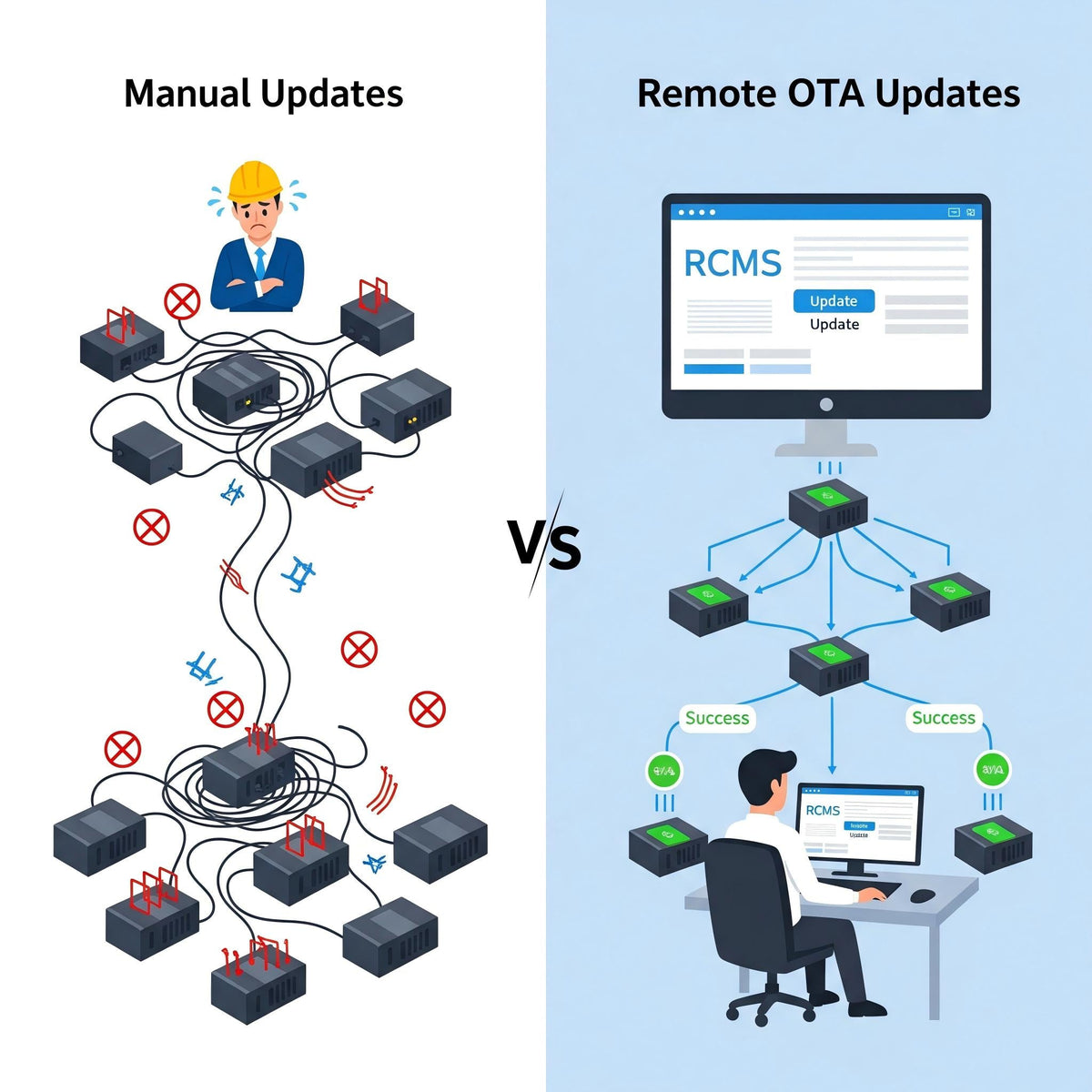
How to Use Remote OTA Updates for IoT Firmware & Containers with RCMS
|
|
Time to read 6 min
|
|
Time to read 6 min
In the world of Industrial IoT (IIoT), deploying your gateways is only the beginning. The real challenge—and cost—often lies in managing those devices over their entire lifecycle.
This guide provides a step-by-step walkthrough of one of the most powerful tools for efficient fleet management: remote OTA updates (Over-the-Air). We'll explore the common pain points of manual updates and show you exactly how to use a centralized cloud platform, Robustel's RCMS, to update both device firmware and Docker containers remotely.
By the end, you'll understand how to enhance security, ensure consistency, and dramatically reduce the operational cost of your IoT deployments.
So, you've successfully deployed a fleet of 500 industrial IoT edge gateways across multiple sites. Your system is running smoothly. Then, a critical security vulnerability is discovered, and you need to patch the firmware on every single device. What's your plan?
If your answer involves sending engineers out in trucks with USB sticks or spending weeks manually SSH-ing into each device one by one, you're facing an operational nightmare. I've seen this exact scenario cripple IoT projects, turning what should be a simple update into a costly, time-consuming, and error-prone ordeal. This is precisely the problem that a robust system for remote OTA updates is designed to solve. It’s a core feature of any serious Industrial IoT Edge Gateway ecosystem and is fundamental to long-term success.
Before we dive into the solution, let's be honest about the challenges of not having a centralized update strategy. Does this sound familiar?
Time-Consuming Manual Deployments: For gateways scattered across various geographical locations, every application deployment or update demands an engineer's on-site presence or tedious remote logins.
Version Control Chaos: Without a uniform way to manage software versions, you inevitably end up with different firmware or application iterations running on various devices. This lack of consistency complicates maintenance and introduces significant risk.
Difficult Remote Monitoring: Gaining real-time insights into the status of applications (like Docker containers) on edge devices can feel like navigating blindfolded. Troubleshooting becomes a guessing game.
Lack of Centralized Oversight: Without a single platform to see the health and deployment status of your entire fleet, making informed decisions about your distributed edge infrastructure is nearly impossible.
These obstacles don't just slow you down; they inflate operational costs and elevate system risks.

A key feature of RCMS is its Docker Manager . This gives you full lifecycle control over the applications running on your gateways. A professional platform for remote OTA updates provides a suite of features to give you complete control:
Unified Image and Version Control: RCMS supports adding and managing multiple Docker image registries (such as Docker Hub or your own private repositories). This ensures that all your edge devices pull and run the correct, certified versions of your applications.
Real-time Container Status Monitoring & Alerting: A robust OTA platform provides real-time visibility into container runtime status, including CPU usage and memory consumption. Should a container stop running, the system can immediately trigger alerts.
Flexible Container Lifecycle Management: You can remotely Start, Stop, Restart, and Delete containers, giving you comprehensive control over your edge applications without ever needing to establish a direct remote connection.

This section provides a simplified overview of the basic process for deploying Docker containers via RCMS, illustrating its convenience.
(Note: This section's structure is preserved for easy screenshot insertion.)
While deploying powerful edge gateways is a great first step, the ability to manage them efficiently and securely over their entire lifecycle is what truly determines the success and TCO of an IoT project. A robust platform for remote OTA updates , like Robustel's RCMS, offers a comprehensive, efficient, and secure solution to the complexities of managing both firmware and containerized applications at the edge. It centralizes distributed device management, automates cumbersome deployments, and visualizes potential risks, thereby helping enterprises accelerate IIoT deployments, optimize operational costs, and maximize the potential of edge intelligence.
A1: OTA stands for "Over-the-Air." A remote OTA update is the process of wirelessly delivering new software, firmware, or configuration updates to devices that are already deployed in the field, without needing physical access to them.
A2: Modern platforms like RCMS separate these tasks for better control. You can schedule a firmware update for the gateway's operating system (RobustOS Pro) and separately manage the lifecycle and updates of your Docker applications. This ensures you can update your app without touching the underlying OS, and vice versa.
A3: All management operations and data transfers through RCMS are conducted via secure, encrypted channels. The platform itself incorporates multi-layered security mechanisms, including role-based access control, ensuring that only authorized users can initiate updates and manage your devices and containers.






